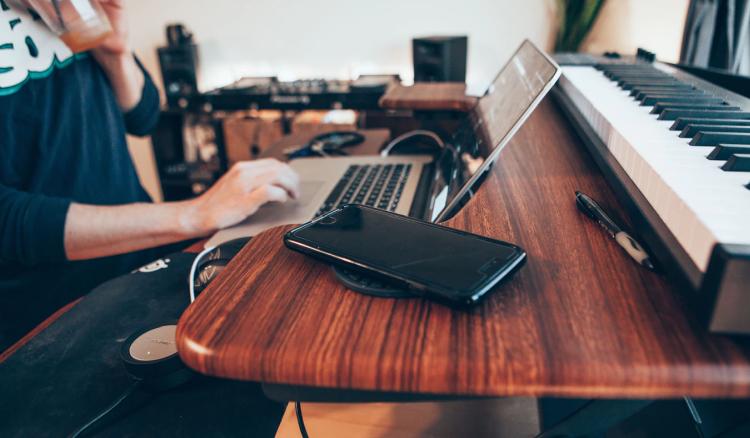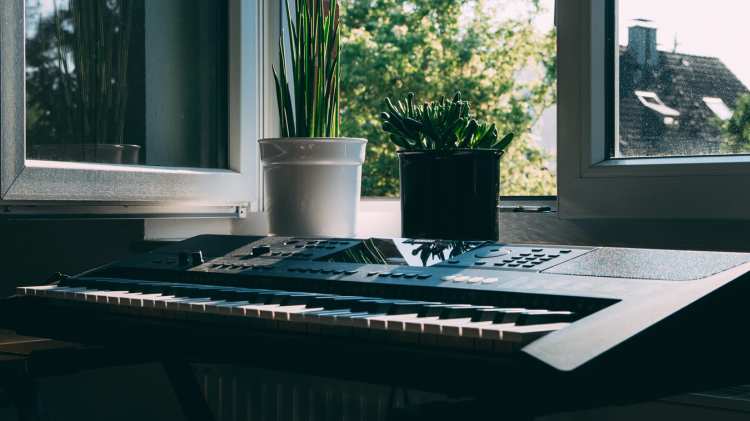Every room has different acoustics. While often few people pay attention to the process of sound propagation in a given place, sometimes it is very important. For example, if someone has the idea of recording vocals or processing recorded tracks (mixing or mastering) in a home room, he or she must take care of acoustic adaptation. This is because microphones (especially condenser and tube microphones) accurately collect sound from every corner of the room. With the use of acoustic panels, the problem of bare walls, and thus sound bouncing off them, can be eliminated. In addition, in such cases, smaller acoustic adaptations are often created, for example, in the corner of the room, such as “cabins” consisting of three acoustic panels. Among them, a microphone stand can be set up.

How to take care of the acoustics of a home recording studio?
The home recording studio should be adapted in such a way that the tracks recorded with the microphone are as clean as possible, that is, free of unwanted sounds. For example, this could be conversations in a neighboring room, cars passing by under the window, or the noise of a turned-on computer. In order for the acoustics of a home recording studio to be optimal, it is necessary to exclude, among other things, room reverberation. Reverberation is the phenomenon of prolonging the duration of sound. This phenomenon usually occurs where there are bare walls. Someone might say that it is enough to hang carpets on them or put in a wall of furniture. This does not fully satisfy acoustic needs, since any such piece of furniture also affects sound frequencies. It used to happen to meet in amateur and home recording studios walls covered with egg stampings. This type ofpseudo-acoustic adaptation was admittedly very cheap, but it particularly negatively affected the frequency distribution of recorded traces. The lower bands of the recorded track sounded tragic. For optimal sound quality of recorded traces and during listening, it is therefore recommended to create the best possible acoustic adaptation. We recommend acoustic panels, acoustic diffusers and acoustic foams made of suitable materials, which are often an important part of acoustic adaptation of a room.
What are the types of acoustic panels?
Acoustic panels are divided into 3 basic groups depending on their application. Different panels are used in a recording studio, and others in a room where we care about simple noise and reverberation reduction. A sports hall and a home recording studio as rooms have different acoustic needs and characteristics.
Sound-absorbing panels – absorbers
So-called absorbers are panels that have a high level of sound absorption. This means that they work well as a room-quieting system. Thanks to such use, the sound from neighboring rooms will not be heard, nor will the sound from the adapted room get outside. Wall-Panel Pro sound-absorbing panels are decorative equipment of this type, the lightweight design of which allows installation both on the wall and on the ceiling. The described acoustic panels are very versatile and suitable for any room. There are also wideband sound absorbers. These types of acoustic panels are great for professional acoustic adaptation, for example, in a recording studio. For example, Studio Spectrum is a broadband absorber based on mineral wool. It works great in rooms that require excellent absorption of all audible frequencies, for example, recording studios or listening rooms.
Acoustic diffusers – diffusers
Acoustic diff users are contraptions whose task is to disperse sound. In recording studios, optimal dispersion of sound makes it very “alive”. All acoustic diffusers are constructed with great precision. Acoustic diff users take a variety of forms and shapes, so they very often decorate the room.BlueTone QRD N17 is a slotted acoustic diffuser, which eliminates unfavorable reflections of sound waves. Dispersing the energy of sound waves over a wide range of frequencies enlivens sound and provides acoustic comfort. Made of leafy plywood, the product is used in areas of early reflections. The listener should be at least 1 meter away from the acoustic diffuser.
Hybrid panels – absorbing and diffusing.
When acoustic panels combine the properties and use of the two types described above they are called hybrid panels . Binary AbFuser is an example of such a product. The mentioned hybrid panel is designed for adaptation of listening rooms. It brilliantly diffuses sound waves in the medium and medium-high ranges, and has high sound absorption. The functions of absorption and diffusion at such a high level make it possible to use the panels in the listening rooms of recording studios, cinema halls, as well as in home theaters. The acoustic panel is made largely of certified acoustic wool.

Bass Traps – bass traps
Bass traps, or so-called bass traps, are characterized by a very high sound absorption coefficient in the lowest bands. Bass tra ps are usually placed in the corners of rooms. Due to the fact that bass traps effectively reduce any rumble and bass boost, they are needed in listening rooms and concert halls. A very popular material for creating bass traps is special mineral wool. Products made of ordinary acoustic foam can often fail the test. This is because acoustic foam attenuates significantly higher frequencies. Tube BassTrap is a high-quality bass trap that, thanks to its shape and high-quality wool with a density of 80kg/m3, provides effective absorption of the lowest tones. Using this type of product in the right location incredibly improves the acoustics of any room.
In which rooms there is often a need for acoustic adaptation
The rooms that can be adapted are not only homes and recording studios. It is very common that audibility is very important in auditoriums and lecture halls. Students at many universities sometimes complain about problems in understanding the words of the lecturer. Despite the good diction of the lecturer, problems of this type can occur. When the room in which the lecture is held is of considerable size and the walls are bare, the reverberation can effectively drown out the lecturer. When adapting this type of room, care should be taken to reduce reverberation as much as possible. Using acoustic baffles in the form of acoustic panels, among others, it is necessary to match the type of baffle to the characteristics of the room. The issue of absorption of the lowest frequencies is irrelevant in such cases. The situation is different when acoustic adaptation of a concert hall is needed. In such situations, the use of Bass Traps, or bass traps, is essential. A large amount of rumble during a concert can interfere with the reception of the songs being played and make it impossible to understand the singer’s words.
When buying acoustic panels, it is a good idea to carefully plan their placement. It is worth bearing in mind that lightweight ceiling systems are perfect for home recording studios. This type of acoustic adaptation, in addition to improving acoustics , will make neighbors much more isolated from the sounds of our room. It is worth buying products of a good brand and with the right application, because optimal acoustic adaptation of rooms is the basis of good sound quality. Whether you are facing the purchase of sound-absorbing panels, acoustic diffusers, hybrid panels or bass traps, it is worth paying attention to the materials used for the contraptions and the quality of their workmanship. High-quality mineral wool is the ideal material used in professional acoustic panels.






